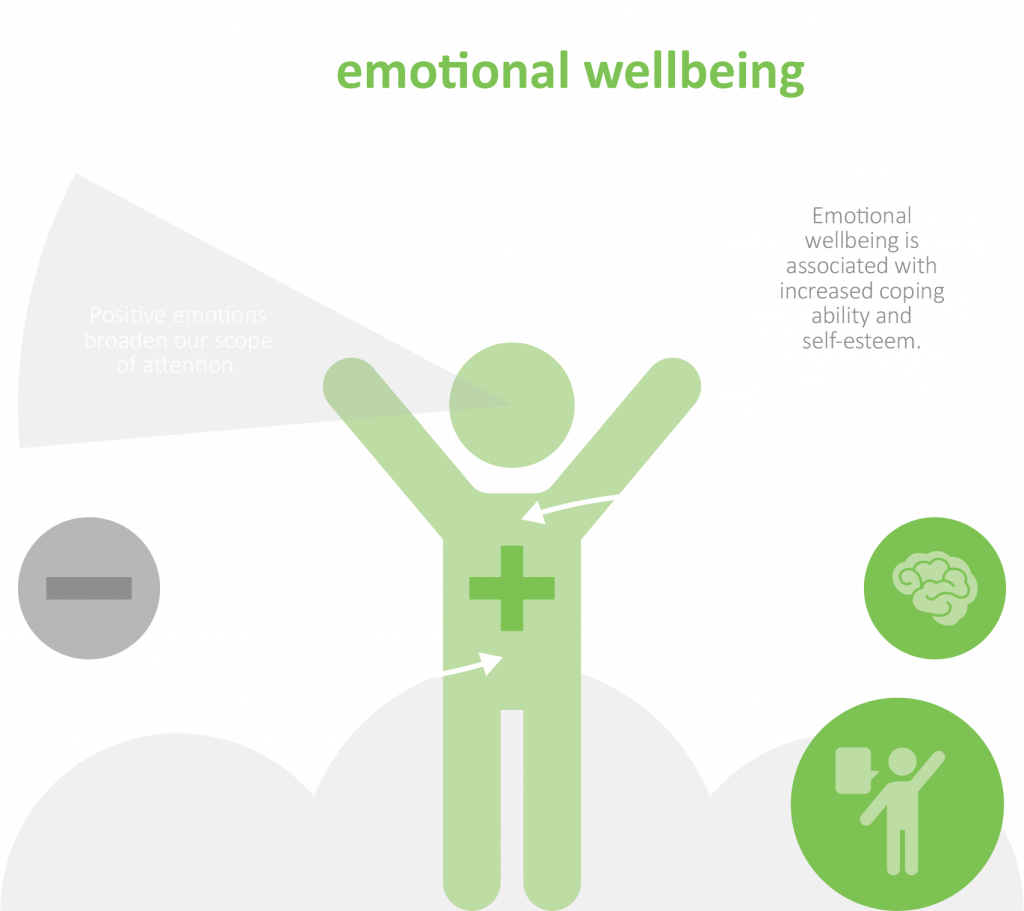Emotional wellbeing relates to self-awareness and emotional regulation.
It includes how well we cope, and is often reflected by the level of a person’s resilience. Emotional wellbeing is in part informed by our capacity for self-reflection.
What are positive emotions?
A key part of emotional wellbeing is our ability to recognise our emotions and experience positive emotions. Positive emotions are those emotions that make us feel good, content, and satisfied. Examples of positive emotions include joy, inspiration, and pride. Feeling positive emotions on a regular basis helps us build additional resources to help deal with life’s ups and downs (resilience).
What is resilience?
Resilience is our ability to adapt to stress and negative life events. Resilience is a key feature for bouncing back from the challenges we face and is a marker for wellbeing
Read more about resilience here.
Did you know?
In order to achieve optimal wellbeing, we need to experience at least three positive emotions for every negative emotion.

Where can I start?
-
Gratitude
-
One way to help us experience more positive emotions is to sit down and reflect on the things that we are grateful for.
- Think about your day so far and what has happened. Can you think of three things that you are grateful for today? Did someone hold open a door for you? Did you bump into an old friend? Did a student stop to talk with you? To help you on your gratitude journey, write these experiences down stating why they were positive.
-
Do things that you enjoy
-
One of the easiest ways to experience positive emotions is to spend time doing the things you enjoy, such as:
- spending time with family and friends
- engaging in hobbies or activities that you enjoy
- listening to music that you love
- exercising to release chemical hormones called endorphins.
-
Take time to reflect
-
A great way to experience more positive emotions at home or at work is to sit down and reflect on your daily challenges and lessons.
- Think about your day and ask yourself what challenged me today? Why was it challenging and how did I manage this challenge?
- Take the time to reflect each day to help identify your emotions and better understand their workings.
-
Extra acts of kindness
-
Doing things for others is not just uplifting to those around you, but can have a positive impact on our own emotional wellbeing.
- An extra act of kindness could be as simple as giving a compliment, helping someone in need, or even giving blood.
- Simple acts of kindness can be large or small. Ideally you should participate in extra acts of kindness on a regular basis.
For more information
-
Resources
-
Resource Name Source Summary Positive emotions open our mind Barbara Fredrickson TED talk highlighting the benefits of positive emotions. The role of positive emotions in positive psychology Barbara Fredrickson Author manuscript on the Broaden-and-Build Theory and key evidence for the role of positive emotions. 4 practical benefits of applying positive emotions Positive Psychology Program The practical benefits of experiencing positive emotions. Wellbeing, Engagement and Behaviour NT SEL (student focus) Northern Territory Department of Education A T-9 social and emotional learning resource built in partnership with students, staff and school communities across the NT. Building resilience (in children and schools) Victoria State Government Information on building resilience at home and school. The positive effects of positive emotions TEDMED, by Jennifer Stellar The power of positive emotions and the role of ‘awe’. Corporate health and wellbeing programs Holistic Services Group Providers of corporate health and wellbeing programs and corporate wellness services.
Where to get help
-
View
-
Your GP is a great place to start. Alternatively these organisations offer a range of resources and assistance for those requiring help for their emotional wellbeing:
- BeyondBlue (people feeling depressed or anxious) Call 1300 22 4636
- Lifeline Australia (people having a personal crisis) Call 13 11 14
- MensLine Australia (for men with family and relationship concerns) Call 1300 78 9978
References
-
View
-
- Fredrickson, B. (2017). The pursuit of happiness. Retrieved on 10th October, 2017, fromhttp://www.pursuit-of-happiness.org/history-of-happiness/barb-fredrickson/
- Eley, D. S., Cloninger, C. R., Walters, L., Laurence, C., Synnott, R., & Wilkinson, D. (2013). The relationship between resilience and personality traits in doctors: implications for enhancing well being. Peer J, e216. Doi:10/7717/peerj.216
- Fredrickson, B. (2001). The role of positive emotions in positive psychology: The broaden-and-build theory of positive emotions. American Psychology, 56, 218-226.
- Ong, A. D., Bergeman, C. S., Bisconti, T. L., & Wallace, K. A. (2006). Psychological resilience, positive emotions, and successful adaptation to stress in later life. Personality Processes and Individual Differences, 91, 730-749.doi:1037/0022-3514.91.4.730
- Fredrickson, B. (2004). Gratitude, like other positive emotions, broadens and builds. In Emmons, R. A., & McCullough, M. E. (Eds.), The Psychology of Gratitude (pp.145-166). Oxford University Press; New York.
- Fredrickson, B., & Branigan, C. (2005). Positive emotions broaden the scope of attention and thought-action repertoires. Cognitive & Emotion, 19, 313-332. http://doi.org/10.1080/02699930441000238
